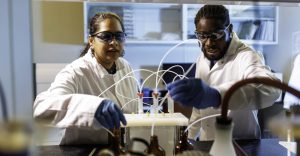
Waste water research in Dr. Kiranmayi Mangalgiri lab in the Noble Research Center at Oklahoma State University in Stillwater on Wednesday, Oct. 8, 2025. (Photo by Mitchell Alcala/OSU Agriculture)
Land-Grant Universities Collaborate on Renewable Energy Innovation
Three land-grant universities — Oklahoma State University, Kansas State University, and the University of Nebraska-Lincoln — are collaborating to determine whether energy production from animal waste and wastewater purification can occur within a single, efficient technology system.
Currently, there are separate technologies that:
-
Generate energy by producing methane from animal waste
-
Clean wastewater for reuse
-
Recover phosphate from agricultural byproducts
“They have all existed in their own silos, and scientists are always working to make these systems more efficient and less harmful to the environment,” said Kiranmayi Mangalgiri, assistant professor of water quality in the OSU Department of Biosystems and Agricultural Engineering.
$6 Million NSF Grant Funds Cross-University Collaboration
National Science Foundation recently awarded $6 million to the universities for this research initiative. The goal is to combine these processes into one integrated system that benefits both producers and the environment.
“We are trying to develop one system for agricultural producers to handle their animal waste while also saving energy and water,” Mangalgiri said. “We also want the process to have little to no impact on the environment and create valuable chemicals like hydrogen peroxide.”
The research aims to use carbon from animal waste to produce renewable energy. A portion of that energy would then be redirected to clean wastewater, allowing it to be safely reused as drinking water or crop irrigation. By doing so, farmers could significantly reduce their dependence on the Ogallala Aquifer, one of the region’s most vital water sources.
Integrating Methane and Wastewater Technologies
At Kansas State University, Professor Prathap Parameswaran, a civil engineer, developed a system that uses microorganisms to produce methane. The new project will expand upon this technology to explore:
-
How advanced wastewater treatment can merge with energy recovery systems
-
How to improve efficiency and cost-effectiveness
-
How to minimize environmental impacts
-
How to adapt the system for producers across the Great Plains region
“This project is different because it is collaborative in every way,” Mangalgiri said. “Instead of one university working on one piece and another university working on another piece, all three universities are working on all the pieces together.”
OSU Leads Wastewater and Antibiotic Research
Mangalgiri is leading the wastewater treatment segment. Mark Krzmarzick, OSU professor and interim head of the School of Civil & Environmental Engineering, is examining antibiotic residues in treated water and identifying microorganisms that may enhance energy recovery.
“Antibiotic resistance happens because bacteria have specific genes that allow them to tolerate chemicals like antibiotics,” Krzmarzick said. “Understanding how we spread or destroy these genes in our wastewater systems helps protect the health of both agricultural workers and animals.”
Understanding Farmer Adoption and Impact
Douglas Hamilton, OSU associate professor of biosystems and agricultural engineering, is collaborating with KSU colleagues to improve energy recovery using microorganisms that help purify water. Meanwhile, Michael Long, OSU professor of sociology, is conducting surveys to learn how farmers might adopt the technology.
“We need to know if producers will view the technology as being worth the investment and if they will reuse the cleaned water for livestock, crops, and the food they eat,” Long said. “We will learn where the technology will be adopted and make a strong, positive impact.”
Source: press release

